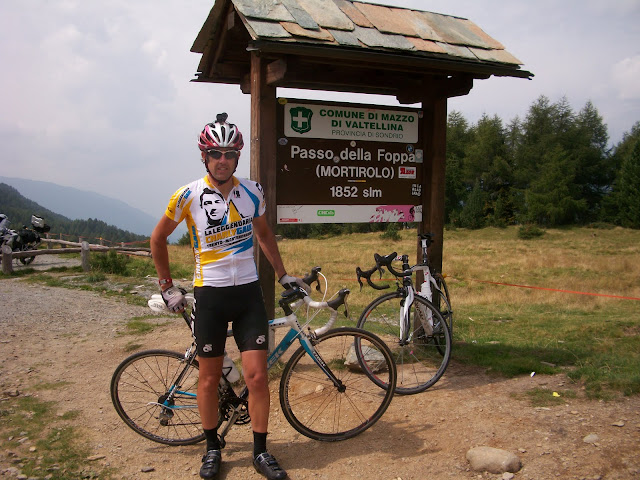Mortirolo was a typical Italian pass, beginning with a narrow road that quietly leads out the back of a small village. The road looked more like a hillside villa driveway than a legendary mountain pass. Many Italian passes are hidden in the woods and you cannot really see much for most of the ascent (Stelvio and many of the Dolomite passes are the exception). Mortirolo immediately aimed for the sky, and stayed that way until the last few kms. I really enjoyed the climb. It hurt - more than i realized - because I could feel the fatigue once I got to Passo Gavia.
Gavia is another legendary Italian pass. It is a Giro d'Italia regular and Gavia is best known for Andy Hampsten’s attack in the 1988 Giro (he went on to win the Giro that year). Although it was June, a fierce snowstorm enveloped Gavia. Apparently, the Europeans in the peloton pleaded with Hampsten not to attack as everyone was wearing their summer kits and no one was prepared for below freezing temperatures. He ignored them and gained precious time. The storm was so bad that team cars and race officials were unable to escort the cyclists up Gavia. YouTube has videos of the racers once they reached the finish in Bormio. They are almost frozen solid, unable to speak, and their exposed skin is a glossy bright red.
I wasn’t sure what to expect from Gavia. I read several ride reports and watched a handful of YouTube videos, but still waters run deep and I had the feeling that Gavia would be quite a ride. About half-way up the 1,363m climb, the clouds moved in, from above and below. In some ways, the clouds ruined the views, however, I got some spectacular cloud formations, and the sun still poked through occasionally. The climb became more and more surreal as I got closer to the 2,652 meter summit: modern guardrails on the lower slopes turned to nothing more than rope and string, a pitch-black 1km tunnel that I had to navigate with my hands (see photos below), and a road surface that felt like it was built by the Roman Empire. But that was all part of “The Gavia Experience”, a climb I could really only describe as “unbelievable."
 |
| The customary pre-ride espresso. |
 |
| Mortirolo is somewhere in the background. |
 |
| There is nothing particularly noteworthy about Mortirolo, except for the steep pitch. |
 |
| Graffiti from the 2010 Giro d'Italia. |
 |
| I met two cyclistas from Pamplona, Spain in the final 2 kms. There were only a handful of cyclists on Mortirolo. |
 |
| The beginning of Passo Gavia. |
 |
| Gavia was hard work right from the start. |
 |
| Steep switchbacks. |
 |
| 8km to the summit. |
 |
| Clouds started to move in. |
 |
| The clouds were above and below. |
 |
| And this road goes to...? |
 |
| Visibility: about 20 meters. |
 |
| Note the rope 'safety' barrier. |
 |
| Passo Gavia is a regular in Italy's annual Giro. |
 |
| Climb profile of Mortirolo (above) and Gavia (below). X-axis is distance (in kms) and Y-axis is elevation. Km-by-km average gradients are typed within each column. |












You must be down to 3% bodyfat by now!
ReplyDelete